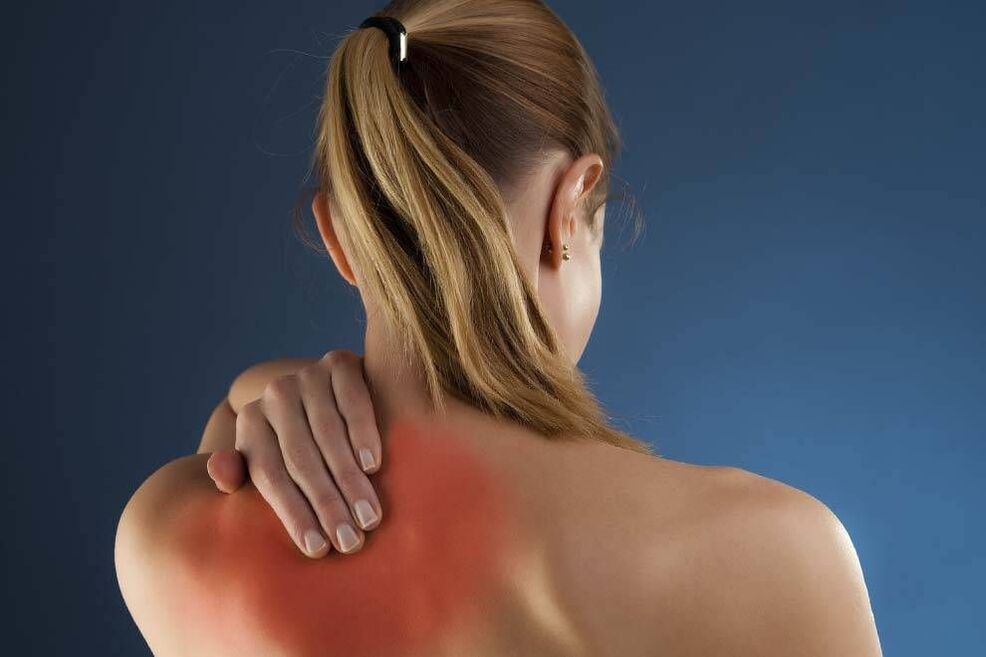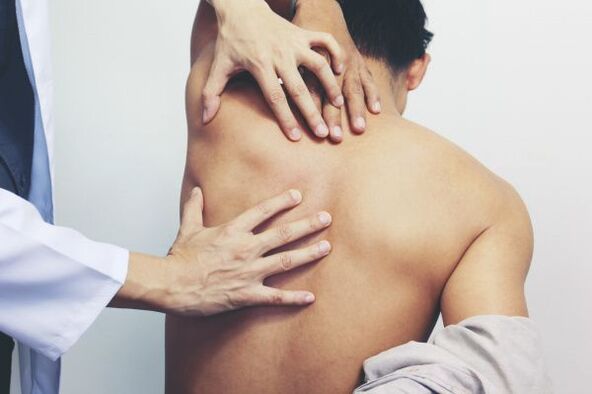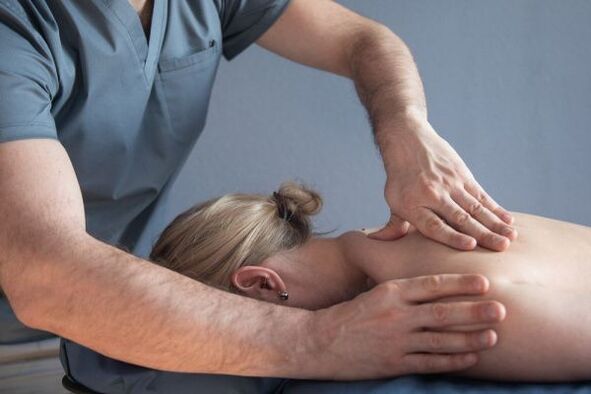
Pain under the left shoulderIt is observed in pathologies of the musculoskeletal system (osteochondrosis, myofascial syndrome, injuries), heart diseases (myocardial infarction, angina pectoris, rheumatic and non-rheumatic carditis), gastrointestinal diseases (pancreatitis, gastric ulcer). Rare causes of the symptom include damage to the spleen, ulcers, and skin tumors. Diagnostic methods are selected according to the main syndrome: X-ray, ultrasound and endoscopic examinations are used. Analgesics are prescribed to relieve pain, after which medical or surgical treatment of the underlying disease is carried out.
Causes of pain under the left shoulder blade
Radicular syndrome
Pathological condition develops with thoracic osteochondrosis or intervertebral hernia. Less often, radicular pain occurs in spondylolisthesis and ankylosing spondylitis. Acute pain in the projection of the left temple is observed when the 3rd-6th thoracic roots are involved in the process; Discomfort directly under the scapula indicates the localization of the lesion in the 7-8 vertebrae. As a rule, the pain spreads from the scapula to the lateral surface of the chest and intercostal spaces.
Myofascial pain syndrome
Bad posture and staying in an uncomfortable position for a long time leads to constant muscle tension. The syndrome manifests as pain in the area of the left scapula when the load is predominantly on this side. The patient feels deep and moderately intense discomfort. At first, the pain is felt only during movement and exertion, but over time it becomes constant. Sometimes radiating pain appears in the forearm or left hand.
injuries
Intense pain develops after a crack or fracture of the scapula or soft tissue hemorrhage. If the integrity of the bone is preserved, the pain is moderate, the person can breathe deeply and move freely. When there is a traumatic injury to the bone structures, sharp pain occurs and the mobility of the arm and shoulder girdle is often limited. A sharp pain is felt when changing position or pressing on the affected area.

Boils and carbuncles
Purulent inflammation of the skin surrounding the left shoulder blade is accompanied by severe pain, which is usually clearly localized. As the boil matures, there are "hanging" sensations, which intensify when palpating the inflamed area or rubbing it with clothes. After the tire breaks down and the necrotic core comes out, the pain decreases. In case of carbuncle, the pain is more intense and the general condition of the patient often worsens.
Heart diseases
Heart damage is a typical cause of pain under the left temporal lobe, which is related to the proximity of the anatomical location and innervation characteristics. In this case, the symptoms are accompanied by various types of pain in the chest, a feeling of freezing or a delay in the functioning of the heart. Tachycardia and other rhythm disturbances are usually detected. Pain under the shoulder blade appears as follows:
- Myocardial infarction.Patients have an unbearable burning sensation that spreads from the precordial region to the left arm and shoulder blade, less often to the neck and nape of the neck. The condition comes on suddenly and is accompanied by a strong fear of death and a weak state.
- Stable angina pectoris.Episodes of squeezing or pressing pain radiating to the subcutaneous area are specific to attacks of ischemic heart disease. Unpleasant symptoms are provoked by physical exertion or emotional stress and last on average 10-15 minutes. After rest or taking nitrates, the pain disappears.
- Inflammatory heart diseases.Acute carditis (myocarditis, pericarditis) is characterized by dull or cutting pain in the chest, which radiates to the left shoulder blade and bothers the patient for several days. The person also complains of shortness of breath, increased body temperature and swelling of the lower limbs.
- Rheumatism.The clinical picture of rheumatic carditis is characterized by radiating pain in the left half of the back along with cardialgia. The clinical picture is complemented by arthralgia, ring-shaped erythema on the skin and rheumatic nodules. Symptoms are more common in children and adolescents.
Pancreatitis
Belt pain, which goes from the left hypochondrium to the subcutaneous area, is observed with acute inflammation of the pancreas. In addition to the pain syndrome, patients suffer from debilitating vomiting of bile and mucus and abdominal muscle tension. Movement intensifies painful sensations, so a person tries to lie motionless on his side.
In chronic pancreatitis, radiating pain under the scapula indicates an exacerbation of the process. Often, disorders are provoked by a mistake in the diet - a big feast, drinking alcohol. The pain is paroxysmal, sometimes it spreads not only subcutaneously, but also in the area of the anus. Symptoms are combined with nausea, flatulence and steatorrhea.
Stomach ulcer
Pain under the left shoulder blade is a sign of localization of the defect on the back wall of the stomach, closer to the back. Unpleasant sensations appear 20-50 minutes after eating. The earlier the symptoms appear, the higher the localization of the ulcer. The discomfort is aggravated when eating sour, spicy or fried food. To reduce the intensity of pain, patients induce vomiting.
Diseases of the spleen
Pain and a feeling of fullness in the left subcutaneous area are manifested by splenomegaly caused by infectious, autoimmune or myeloproliferative processes. As the organ gradually enlarges, periodic discomfort develops in the affected area with heaviness, and a rapid change in the size of the spleen is accompanied by sharp stabbing pains radiating under the left shoulder blade.
Less often, the cause of pain is surgical pathologies of the spleen: rupture, infarction, volvulus. In this case, there are sharp or throbbing pains radiating under the scapula, which are aggravated by the slightest movement. Therefore, the patient takes a forced position: lying on the left side or on the back, with knees tied to the stomach. The clinical picture is complemented by a sharp drop in blood pressure and tachycardia. In the absence of adequate pain relief, shock occurs.
Bronchopulmonary pathologies
Left-sided focal processes in the lungs often cause pain in the projection of the scapula. Discomfort increases with deep breathing, laughing and talking, and coughing fits. Pain has a diverse character: sharp, cutting, dull, pressing. They are accompanied by fever, shortness of breath and other typical respiratory symptoms. Most often, patients who develop pain under the left shoulder blade experience:
- Pneumonia.The patient feels a moderate dull pain, which has a clear localization during focal inflammation of the lungs or extends to the scrotum area during pulmonary pneumonia. A deep cough occurs with the release of mucous purulent sputum. Symptoms last 2-4 weeks.
- Pleurisy.In exudative pleurisy, a person experiences pressure and bursting under the scapula and along the side wall of the chest. When you feel this area, the discomfort intensifies. Dry pleurisy is characterized by acute pain in the chest and subcutaneous area, which intensifies during movement.
- Tuberculosis.Tuberculosis infection lasts for a long time, so pain of low intensity lasts for several months. If the pain is localized in the area of the scapula, the pathological focus is more likely to be located in the posterior segments of the lung.
- pulmonary infarction.The death of the lung parenchyma section is manifested by severe pain radiating under the left shoulder blade, clinically similar to an attack of angina pectoris. The condition of patients is complicated by hemoptysis or pulmonary bleeding, external breathing dysfunction and arrhythmias.
Rare causes
- neoplasms: osteoma and osteosarcoma, bone cyst, malignant tumors of the skin above the scapula (basal cell carcinoma, melanoma).
- Rare cardiovascular pathologies: Cardiac syndrome X, Aneurysm of the descending aorta.
- Acute surgical diseases: retroperitoneal abscess, hemoperitoneum, compressed diaphragmatic hernia.
diagnosis
Patients with pain under the left shoulder first refer to an orthopedic traumatologist for consultation. If there are no disorders of the musculoskeletal system, other specialists are involved in the diagnostic search: neurologist, cardiologist, surgeon, etc. Sh. To determine the causes of pain, a full range of instrumental studies is prescribed, which includes:
- Radiography.X-ray of the scapula in the frontal and lateral projections allows you to exclude or confirm a traumatic injury. Radiographic imaging of the spine is indicated when osteochondrosis, scoliosis or spondylolisthesis is suspected. A plain X-ray of the chest cavity allows suspicion of lung or heart damage.
- Electrocardiography.A standard 12-lead electrocardiogram is a screening method based on the results of which the doctor makes a preliminary diagnosis and identifies dangerous processes (myocardial infarction, life-threatening arrhythmias). The diagnostic complex is complemented by classic or transesophageal echocardiography and electrophysiology of the heart.
- Ultrasound of abdominal organs.A quick and non-invasive method is used to detect common conditions that cause pain in the left shoulder blade. Ultrasound examination reveals signs of gastric ulcer, inflammatory infiltration of pancreas and enlarged spleen. EGD is used to clarify the diagnosis of peptic ulcer.
- additional methods. CT or MRI of the spine is performed to clarify the nature and severity of bone changes. In case of suspected bronchopulmonary diseases, bronchoscopy with biopsy and pleural puncture are performed. If there are difficulties in diagnosing abdominal pathology, diagnostic laparoscopy is recommended.
Laboratory methods play a major role in diagnosis. A clinical blood test shows signs of inflammation or disorders of hematopoietic processes. Indicators of acute phase proteins and proteinograms are informative in case of possible heart damage or autoimmune process. Myocardial-specific markers have been evaluated for angina pectoris pain.
A coprogram is performed to diagnose gastrointestinal diseases: the presence of pancreatitis is indicated by a high content of indigestible food particles, an increase in the number of striated muscle fibers and starch grains. In the case of inflammatory processes of the lungs and pleura, it is necessary to bacteriologically inoculate the biomaterial, followed by the antibiotic sensitivity test of the isolated microorganisms.

treatment
Help before diagnosis
Given the variety of causes of pain under the left shoulder blade, it is extremely difficult for a doctor to give recommendations until the underlying pathology is identified. During the examination, it is advisable to reduce the load on the back muscles in order to eliminate easy fatigue and excessive load, which can cause constant pain symptoms. If the sensations are unbearable, analgesics are used and the patient is hospitalized immediately.
conservative therapy
A treatment plan is selected only after a complete diagnosis and determination of the etiological factors of pain under the left side. If the patient suffers from severe discomfort, anti-inflammatory drugs and muscle relaxants are recommended, which quickly relieve painful sensations. In case of severe pain, therapeutic blockade and administration of narcotic analgesics are effective. Taking into account the disease, the mode of physical activity is selected.
Drug therapy is prescribed by a specialist of the appropriate profile. In the case of pain due to heart damage, the cardiologist prescribes antianginal and antiarrhythmic drugs, antiplatelet and anticoagulants, and antihypertensive drugs. Diseases of the bronchial-pulmonary system require the participation of a pulmonologist and the use of antibiotics, expectorants and specific anti-tuberculosis drugs.
In case of gastrointestinal pathologies, a suitable diet is chosen and enzyme preparations, prokinetics, antacids and antisecretory drugs are added to the therapy. In neurology, neurometabolic agents, B vitamins and drugs that improve blood microcirculation and rheological properties are shown to eliminate radicular syndrome.
Non-narcotic methods are actively used for postural disorders and other spine problems: traction therapy, therapeutic massage, exercise therapy. Balneotherapy (sulphide and radon baths), mud therapy and reflexology are popular among physiotherapeutic methods. It is possible to increase the effectiveness of drug treatment by electrophoresis of drugs directly on the affected area.
surgery
Surgical methods are indicated when conservative treatment is ineffective or in life-threatening pathologies, when delay is dangerous for the patient's life and health. The second group of operations includes stenting methods, angioplasty and bypass surgery methods for myocardial infarction, assistance of abdominal or thoracic surgeons during injuries, purulent processes and internal bleeding.
Planned surgical interventions are often prescribed in neurosurgery for severe radicular syndrome and intervertebral hernia. Microdiscectomy and laser vaporization of the disc are performed to eliminate pain associated with compression of nerve structures. In rare cases, stabilization operations are applied to the spine (interbody fusion, use of a halo device, transpedicle fixation).

















































